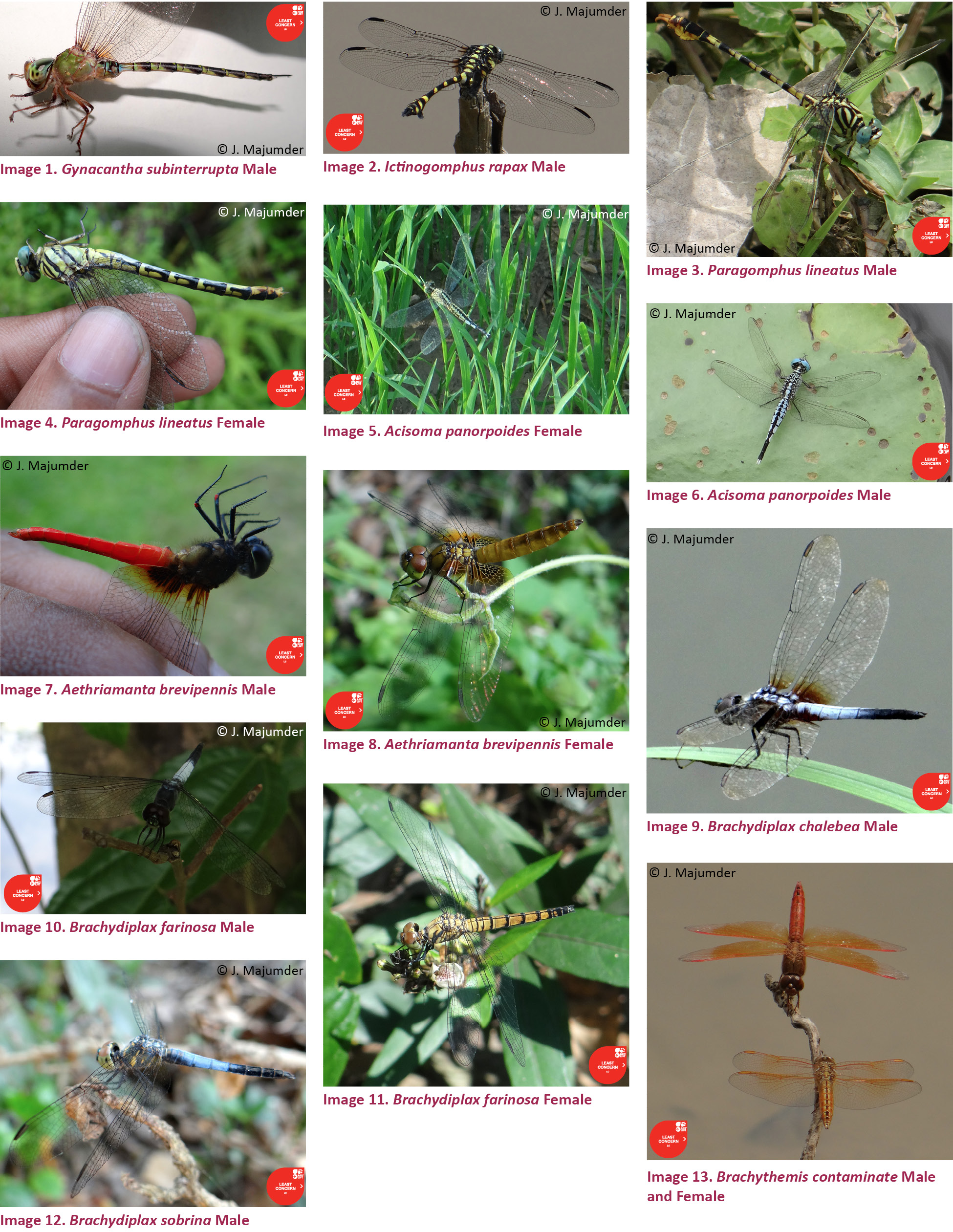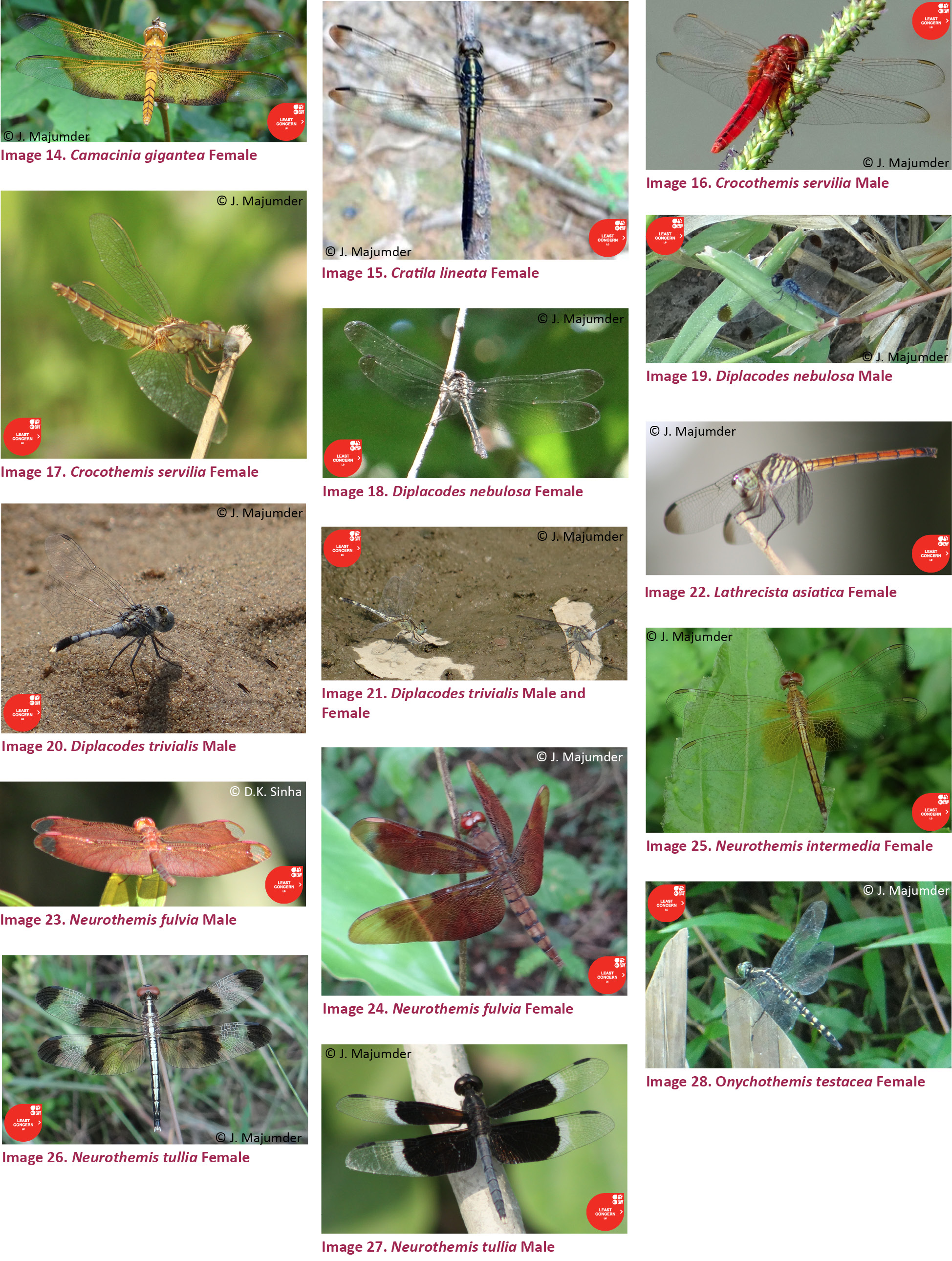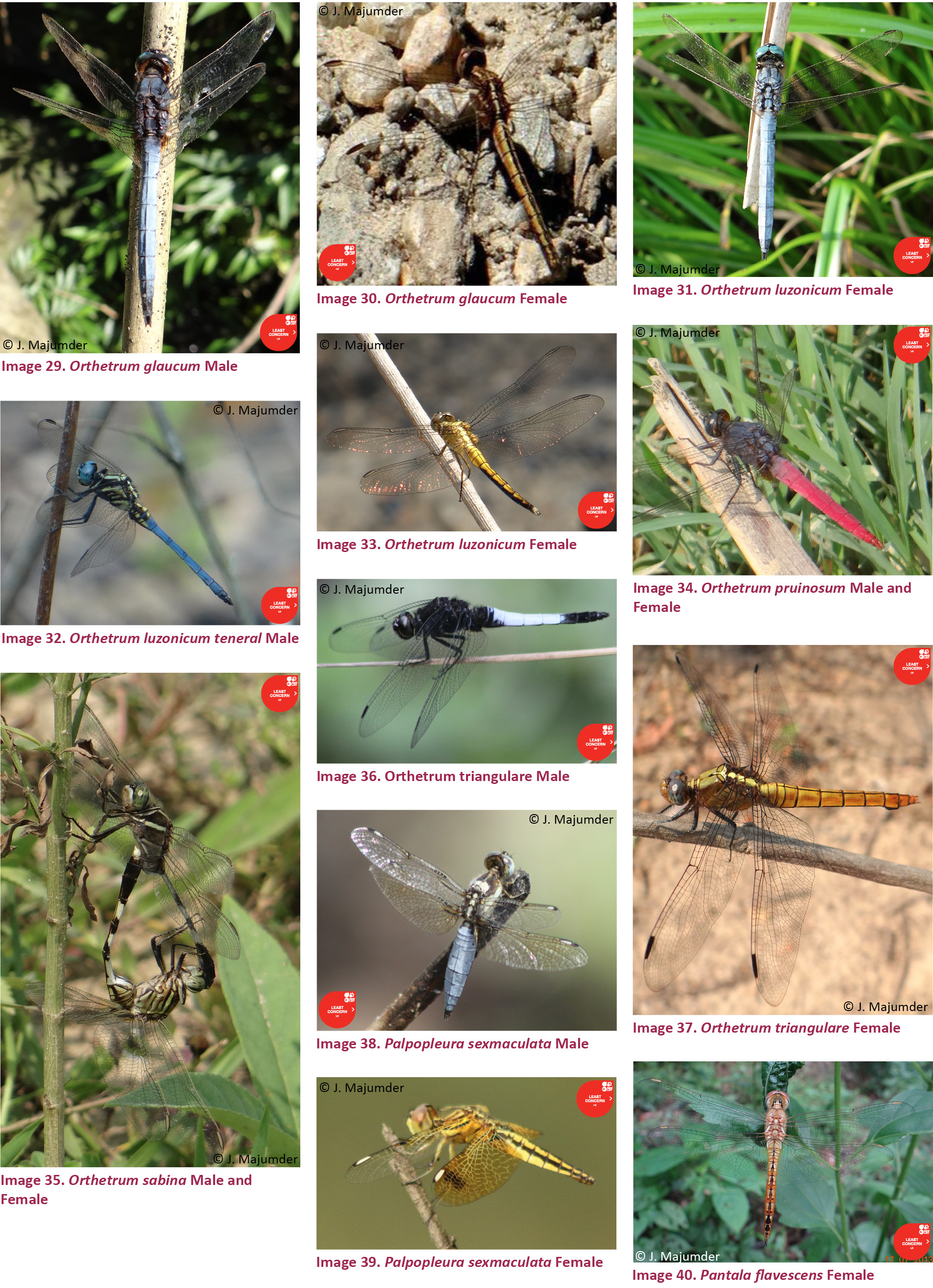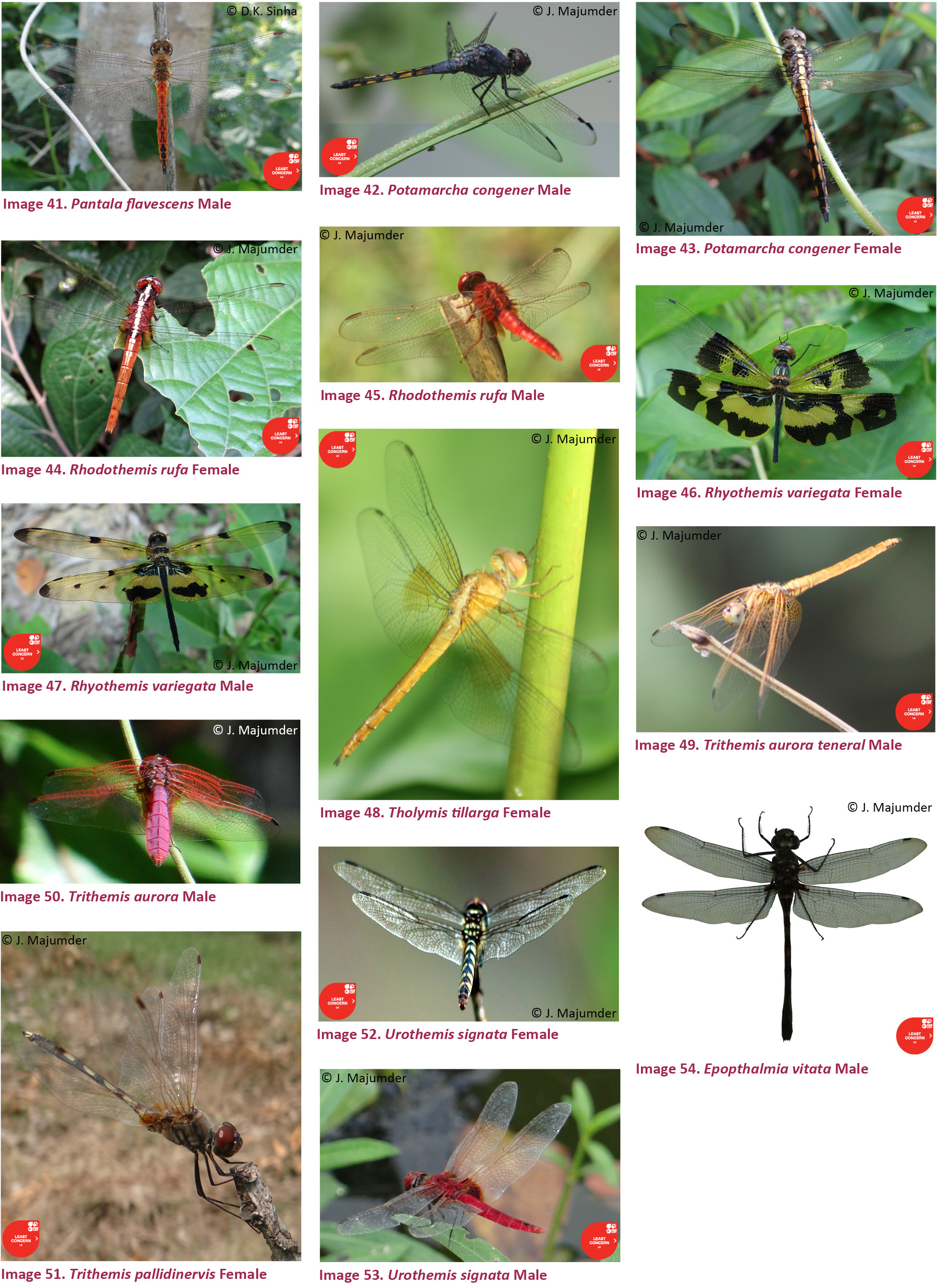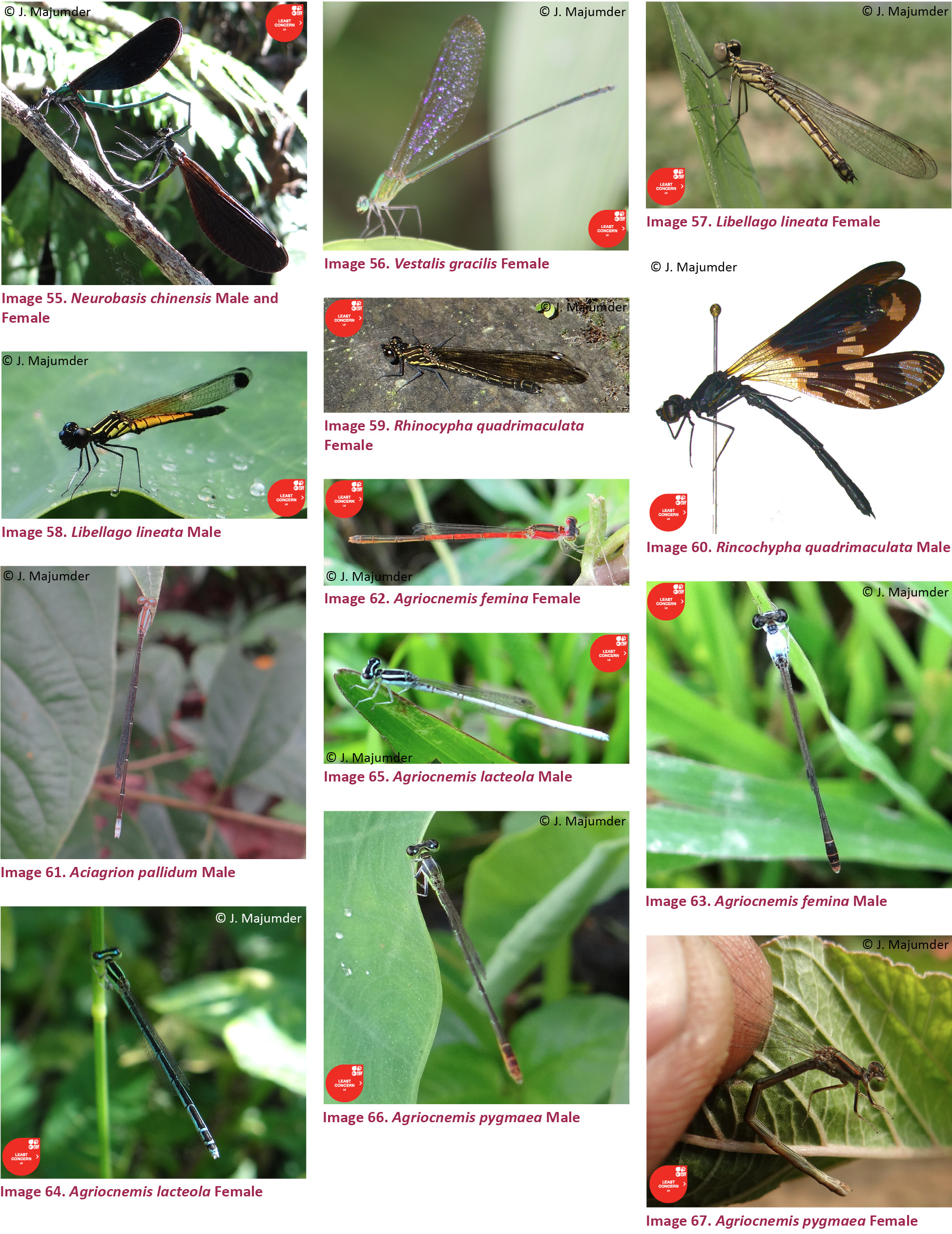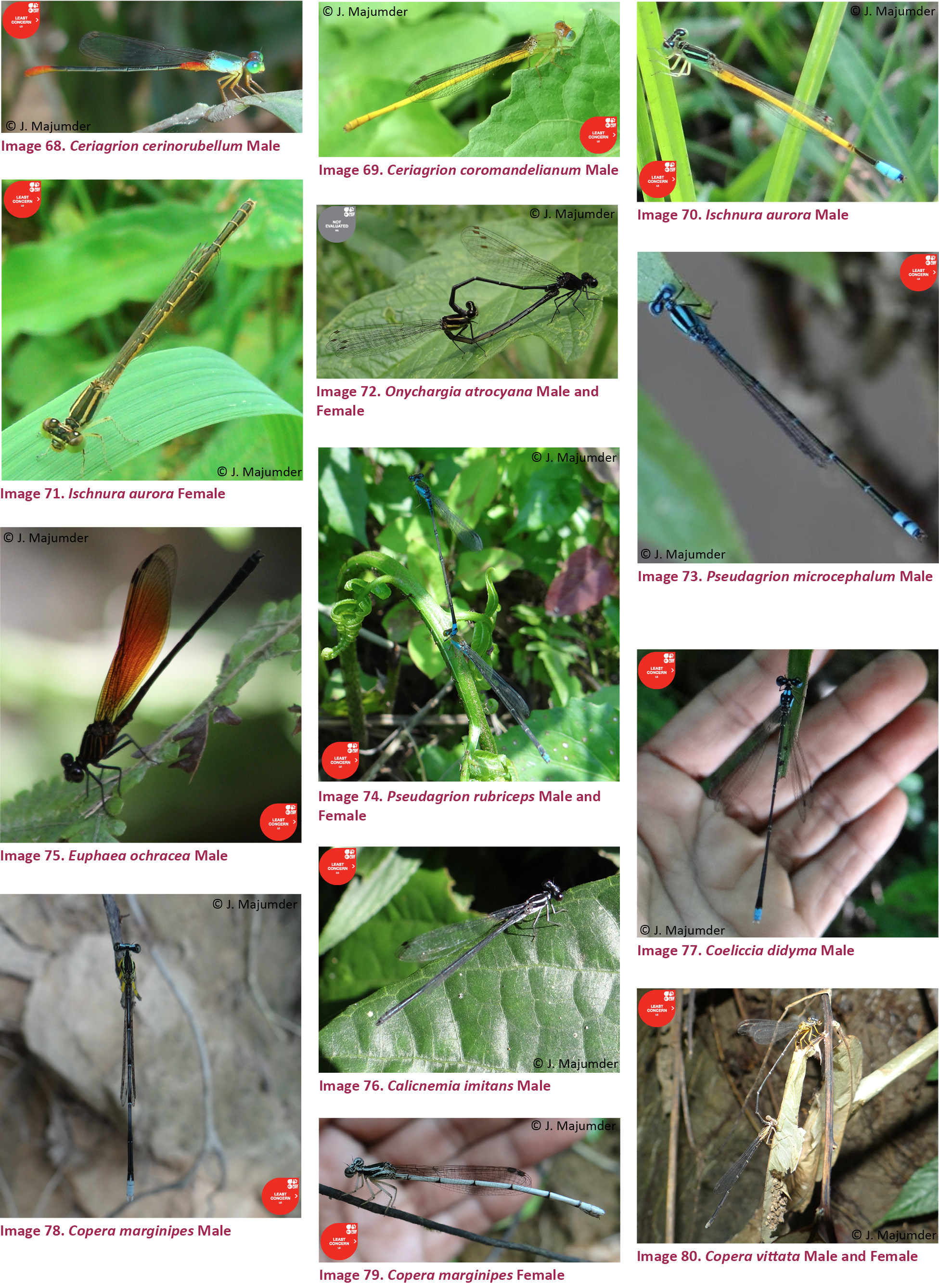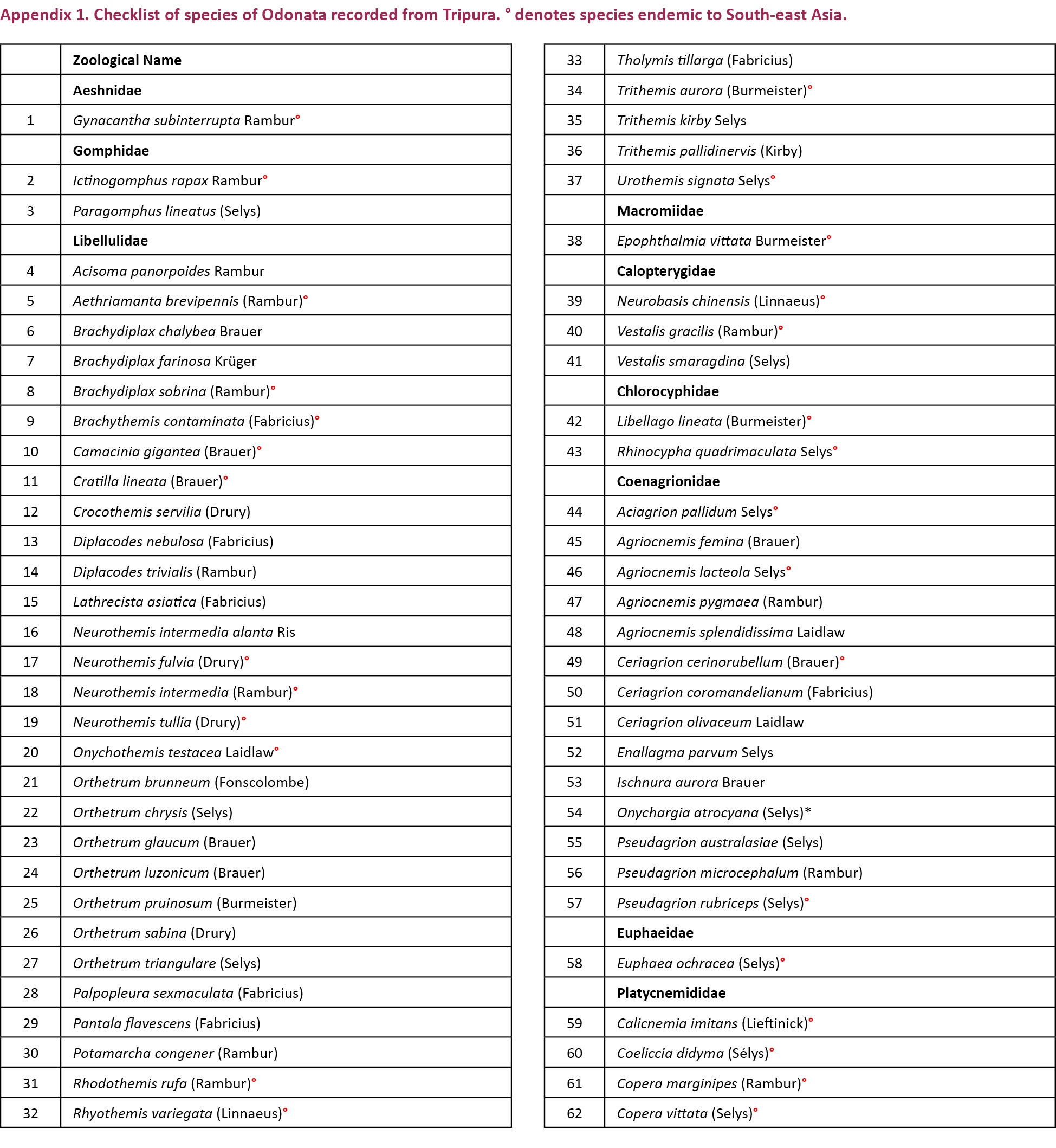Dragonflies and damselflies (Insecta: Odonata) of Tripura, northeastern India with a pictorial catalogue
Joydeb Majumder 1, Partha Pratim Bhattacharjee 2 & Basant K. Agarwala 3
1,2,3 Ecology and Biodiversity Laboratories, Department of Zoology, Tripura University, Suryamaninagar, Tripura 799022, India
1 jmtugemo@gmail.com, 2 bhattacharjee.pp1977@gmail.com, 3 bagarwala00@gmail.com (corresponding author)
Abstract: A survey of Odonata was conducted in four reserve forests, three wildlife sanctuaries and three unclassified natural areas of Tripura, northeastern India from 2008 to 2012, from May to August. A total of 53 species belonging to 37 genera under nine families of Zygoptera (damselflies) and Anisoptera (dragonflies) were recorded in five years from 1370 points by direct search. This included 25 species, 16 genera and five families reported as new records for the state. A list of the species, number of specimens examined, their habitats, local and IUCN status, and worldwide distribution are provided. A pictorial catalogue of adults of the recorded species is also provided.
Keywords: Biodiversity, distribution, eastern Himalaya, Odonata, Tripura.

doi: http://dx.doi.org/10.11609/JoTT.o3750.6683-702 | ZooBank: urn:lsid:zoobank.org:pub:041ADCEE-F6EB-4794-AF5C-0B58C5439B21
Editor: K.A. Subramanian, Zoological Survey of India, Kolkata, India. Date of publication: 26 December 2014 (online & print)
Manuscript details: Ms # o3750 | Received 18 August 2013 | Final received 09 October 2014 | Finally accepted 20 October 2014
Citation: Majumder, J., P.P. Bhattacharjee & B.K. Agarwala (2014). Dragonflies and damselflies (Insecta: Odonata) of Tripura, northeastern India with a pictorial catalogue. Journal of Threatened Taxa 6(14): 6683–6702; http://dx.doi.org/10.11609/JoTT.o3750.6683-702
Copyright: © Majumder et al. 2014. Creative Commons Attribution 4.0 International License. JoTT allows unrestricted use of this article in any medium, reproduction and distribution by providing adequate credit to the authors and the source of publication.
Funding: This study was supported by Indian Council of Agricultural Research, New Delhi through a project no. F.No. 16-16/2007-IA IV to the corresponding author (B.K. Agarwala).
Competing Interest: The authors declare no competing interests.
Acknowledgements: The study was conducted as a part of the National Project on Insect Biosystematics funded by Indian Council of Agricultural Research, New Delhi, India. Authors express their gratitude to Dr. V.V. Ramamurthy, Principal Scientist, NPIB, New Delhi, for his constant encouragement. Authors are thankful to Dipankar Kishore Sinha for his tireless help in the field and to Shantanu Joshi for his comments on the identification of several odonate species reported here.
Insects occupy three-fourths of all described species of animals on the planet (Westfall & Tennessen 1996). While most insects live on land, their diversity also includes about 76,000 species of aquatic insects (Balian et al. 2008). The importance and appropriateness of invertebrate taxa as ecological indicators in monitoring ecosystem health are well recognized (Merritt et al. 2008; Majumder et al. 2013a), and Odonata, popularly known as dragonflies (Anisoptera) and damselflies (Zygoptera), are one such insect group (Corbet 1999; Foote & Rice 2005; Samways et al. 2010). Odonates are among the most primitive of winged insects dating back to the Permian (Grimaldi & Engel 2005) and are very striking and attractive among the flying insects. They occur worldwide in varied ecological niches extending from sea level to over 3600m altitude and from brackish, marshy area, mangroves to semi-arid areas (Kalkman et al. 2008). They are amphibious with the adults being terrestrial and the larvae aquatic. Majority of the known species are highly specific to their habitats and are highly sensitive to changes in habitat quality (Smith et al. 2007; Silva et al. 2010). The insect diversity in a particular area or habitat has the potential to serve as a reliable indicator of stability, health, and integrity of aquatic (Foote & Rice 2005; Osborn 2005) as well as terrestrial ecosystems (Brown 1991; Clausnitzer 2003), and can be used as the predictor of other taxa present in the studied habitats (Oliver & Beattie 1993; Wilson 1997). Besides, these insects also play an important role in the prey-predator dynamics of natural ecosystems (Das et al. 2012). Dragonflies are also used as food and medicinal resources at a local scale (Kalkman et al. 2008; Shantibala et al. 2012).
Approximately, 6,500 extant species of Odonata are found worldwide representing about 600 genera (Vick 2002). About 1,500 species have been reported from the tropical rainforest regions (Kalkman et al. 2008). It is acknowledged that proportionately fewer studies were carried out on odonate diversity of this region (Corbet 2006). Many species in tropical forests are known from the type specimens alone (Clausnitzer et al. 2009). Prasad & Varshney (1995) and Mitra (2006) reported 499 species and sub-species under 139 genera, 17 families, and three sub-orders of Odonata from India which was later revised to 463 species (Subramanian 2009). Among the states of northeastern parts of India, Nagaland consists of 90 species under 53 genera and 14 families (Joshi & Kunte 2014), Mizoram by 64 species under 41 genera and 12 families (Prasad 2007), Manipur by 68 species under 41 genera and eight families (Srivastava & Sinha 2004), and Sikkim by 65 species under 34 genera and 11 families (Mitra 2003). At the time of this study, Tripura State was represented by 37 species under 21 genera and five families (Srivastava & Sinha 2000; Majumder et al. 2013a).
In view of the heterogeneous landscape of Tripura with diverse ecosystems including a large number of fresh water bodies consisting of several rivers, lakes, streams, ponds and canals (Majumder et al. 2012), it was thought that extensive exploration of remote and previously un-explored locations of Tripura State could bring out many more species of Odonata from this geographical region which had been sparingly surveyed for fauna and flora in the past (Agarwala & Bhattacharjee 2012). Accordingly a faunastic study was carried out for insect diversity from 2008–2012. A part of the results of that study is presented here. A pictorial catalogue of adults of the recorded species is provided.
Methods and Materials
Study area
Geographically, Tripura lies between 22056’–24032’N & 91010’–92021’E, and is the meeting point of two biodiversity hotspots, the eastern Himalaya hotspot in the east and the Indo-Myanmar hotspot in the west and, thus, occupies a critical position in the global biodiversity scene (Myers et al. 2000). The landscape of the state is dominated by 11 rivers, and six mountain ranges (Fig. 1) which create numerous ecological niches and biotopes ranging from hilly terrain with undulating slopes, valleys and plains dominated by semi-evergreen to moist deciduous forests and secondary bamboo brakes. Tropical climatic conditions prevail in Tripura with an average annual rainfall of about 2100mm from the southwest monsoon. Average annual temperatures range between 10–36 0C, with altitudes varying from 15–850 m (Majumder et al. 2013b).
Ten natural biotopes comprising four reserve forests (RF), three wildlife sanctuaries (PA) and three unclassified natural forests (UF) were chosen for a survey of odonates (Fig. 1). They are (1) Ballianchip (BC, RF, Kanchanpur), (2) Debbari (DB, RF, Amarpur), (3) Srirampur (SP, RF, Kamalpur), (4) Unakoti (UK, RF, Kailasahar), (5) Gomati Wildlife Sanctuary (GWS, PA, Jatanbari), (6) Rowa Wildlife Sanctuary (RWS, PA, Dharmanagar), (7) Trishna Wildlife Sanctuary (TWS, PA, Belonia), (8) Ishanchandranagar (ICN, UF, Bishalgarh), (9) Khupilong (KP, UF, Udaipur), and (10) West Bhubanban (WB, UF, Agartala). Data of latitude, longitude, altitude and habitat features of all the locations are provided in Table 1. Hereafter, only abbreviated names of locations are used.
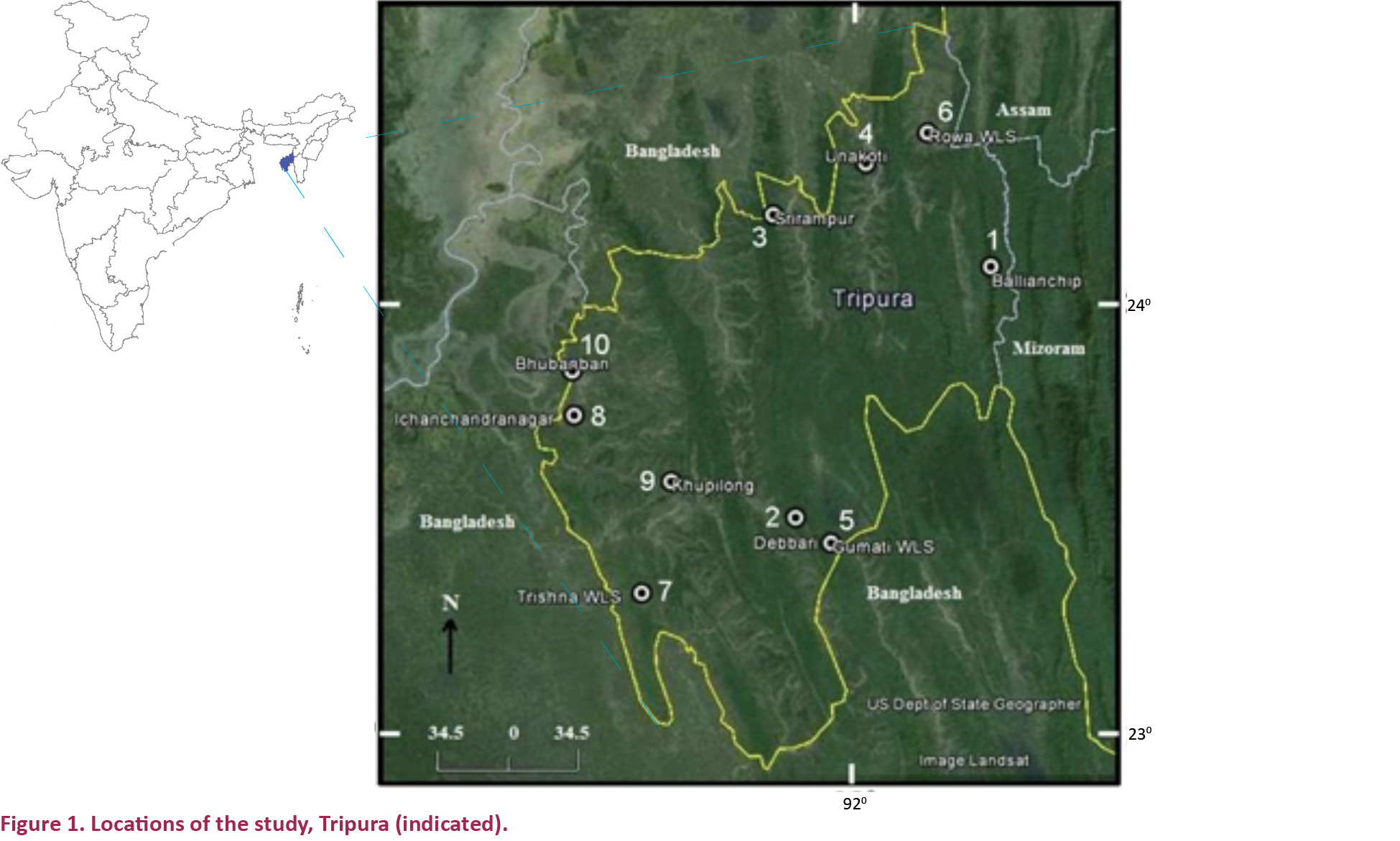
Field sampling
The study was carried out from 2008 to 2012, from the months of May to August, considered to be favourable for the occurrence of adult odonates (Das et al. 2013). Data were collected by direct search technique (Sutherland 1996) at the potential habitats of odonates. For this purpose, 10–15 min halts were made at each search point chosen at random. During the five-year sampling period, collections/observations from 1,370 points were made. All the records were made during 800–1400 hr as odonates are found to be most active during this time of the day. Opportunistic sightings were also made to record maximum species richness. Specimens were photographed and initially identified in the field based on field guides of Nair (2011) and Subramanian (2009). In case of difficulty in field identification of specimens, one or two specimens, depending on their natural abundance, of each species were captured using insect nets for proper identification and preservation in the laboratory following the method of Fraser (1933–36). The classification scheme followed here was based on Schorr et al. (2009) and Dijkstra et al. (2014). The annotated checklist of species is presented alphabetically under respective suborder and family. Collected specimens and photographs of all the specimens from this study are kept in the Ecology and Biodiversity laboratories of Tripura University. Photographs were taken using Canon 50D and Sony Cyber-Shot HX200V cameras. Specimens of the previous records were not available for examination to the authors, therefore, the results presented here is confined to the actual specimens of 52 species under 37 genera and nine families that were either collected or photographed in the field and examined during this study.
Data analysis
The recorded odonate species are considered under four categories based on their relative occurrence in the study area, viz., (i) common species represented by >100 sightings, (ii) frequent species represented by <100 sightings but >50 sightings, (iii) occasional species represented by <50 sightings but >10 sightings, and (iv) rare species represented by <10 sightings. Conservation status of Odonata species recorded in this study was determined according to international conservation categories, viz., LC = Least Concern and NE = Not Evaluated (IUCN 2013).
Results
The result comprises records of 53 species under 37 genera and nine families of dragonflies and damselflies. These included 25 species, 16 genera and four families reported here as new records from the state. Together with the earlier records (Srivastava & Sinha 2000; Majumder et al. 2013a), the odonate fauna of the state is now represented by 62 species under 39 genera and nine families. In the present study 53 species belonging to 37 genera in nine families were recorded. These included 33 dragonfly species (Anisoptera) and 20 damselfly species (Zygoptera). A family-wise list of species with number and sex of specimens examined, their habitat and distribution, local occurrence, and IUCN status are provided. Photographs of recorded species are provided in Images 1–80.
Family-wise records of species showed that Libellulidae is found to be the largest family represented by 29 species under 19 genera followed by Coenagrionidae (10 species, 6 genera), Platycnemididae (4 species, 3 genera), Calopterygidae (2 species, 2 genera), Chlorocyphidae (2 species, 2 genera), Gomphidae (2 species, 2 genera), Macromiidae (1 species), Aeshnidae (1 species), and Euphaeidae (1 species), respectively. New reports of species and families from Tripura are indicated by the signs * and #, respectively, after their names. New reports of genera are those represented by new report of single species only.
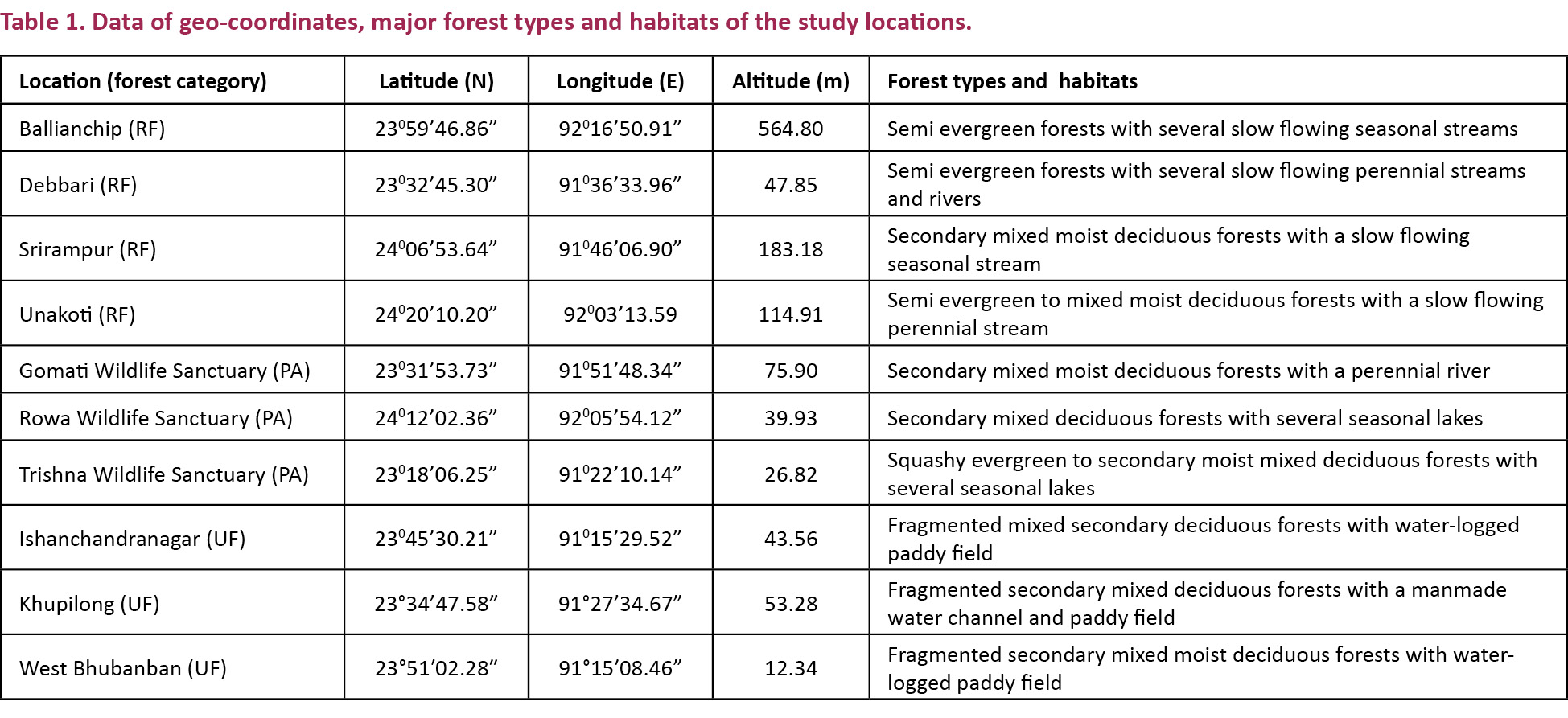
Suborder: Anisoptera Selys, 1854
Family: Aeshnidae Rambur, 1842 #
1. Gynacantha subinterrupta Rambur, 1842*
Material examined: 1 male (TU/Odo/Aesh-3199), 18.vi.2010, 23026’N & 91028’E, TWS; 1 male (TU/Odo/Aesh-4421), 25.viii.2012, 23051’N & 91015’E, ICN; 1 female (TU/Odo/Aesh-4186), 25.iii.2014, 23045’N & 91016’E, ICN, coll. J. Majumder.
Habitat: Shady vegetation on the bank of ponds, lakes.
Conservation status: Occasional; LC.
Distribution: Cambodia, China, India, Indonesia, Lao People’s Democratic Republic, Malaysia, Myanmar, Nepal, Singapore, Thailand and Vietnam.
Family: Gomphidae Rambur, 1842
2. Ictinogomphus rapax Rambur, 1842*
Material examined: 1 male (TU/IMG/ODO/0001), 12.v.2008, 23034’N & 91027’E, KL; 1 male (TU/IMG/ODO/0002), 22.vii.2008, 23051’N & 91015’E, ICN; 1 male (TU/IMG/ODO/0003), 22.vi.2009, 24017’N & 24017’E, RWS, coll. J. Majumder.
Habitat: Open areas on banks of perennial ponds, lakes, stream and rivers
Conservation status: Occasional; LC.
Distribution: Bangladesh, India, Malaysia, Myanmar, Nepal, Sri Lanka, Thailand and Vietnam.
3. Paragomphus lineatus (Selys, 1850)
Material examined: 1 male (TU/IMG/ODO/0005), 11.vi.2010, 23034’N & 91027’E, KL; 1 female (TU/Odo/Gomp-4437), 16.vii.2012, 23031’N & 91033’E, DB, coll. J. Majumder.
Habitat: Open areas near banks of perennial ponds, lakes and forested stream margins.
Conservation status: Occasional; LC.
Distribution: Afghanistan, India, Iran, Nepal, Pakistan, Syrian Arab Republic and Turkey.
Family: Libellulidae Rambur, 1842
4. Acisoma panorpoides Rambur, 1842
Material examined: 1 female (TU/IMG/ODO/0006), 10.vii.2008, 23034’N & 91027’E, KL; 1 male (TU/IMG/ODO/0007), 21.v.2009, 23026’N & 91028’E, TWS, coll. J. Majumder; 1 male (TU/IMG/ODO/0008), 09.viii.2008, 23051’N & 91015’E, ICN, coll. P.P. Bhattacharjee.
Habitat: Paddy fields, marshy areas.
Conservation status: Frequent in Tripura; LC.
Distribution: Algeria, Angola, Benin, Botswana, Burkina Faso, Chad, China, Côte d’Ivoire, Egypt, Equatorial Guinea, Ethiopia, Gambia, Ghana, Guinea, Hong Kong, India, Indonesia, Japan, Kenya, Liberia, Libya, Madagascar, Malawi, Malaysia, Mozambique, Myanmar, Namibia, Nepal, Nigeria, Pakistan, Philippines, Senegal, Sierra Leone, Singapore, South Africa, Sri Lanka, Swaziland, Taiwan, Tanzania, Thailand, Togo, Uganda, Vietnam, Zambia and Zimbabwe.
5. Aethriamanta brevipennis (Rambur, 1842)*
Material examined: 1 female (TU/IMG/ODO/009), 14.vii.2011, 23031’N & 91033’E, DB; 1 male (TU/Odo/Libe-4423), 14.vi.2008, 23026’N & 91028’E, TWS, coll. J. Majumder.
Habitat: Ponds and lakes covered with weeds, water-logged vegetative areas.
Conservation status: Frequent; LC.
Distribution: Bangladesh, Indonesia, India, Laos, Malaysia, Myanmar, Singapore, Sri Lanka, Thailand and Vietnam.
6. Brachydiplax chalybea Brauer, 1868*
Material examined: 1 male (TU/Odo/Libe-3189), 05.v.2011, 23025’N & 91049’E, GWS; 1 male (TU/IMG/ODO/0010), 10.viii.2011, 24007’N & 91046’E, SP, coll. J. Majumder.
Habitat: Marshy areas, eutrophic ponds and lakes, vegetation rich areas near slow streams.
Conservation status: Frequent; LC.
Distribution: Brunei, Darussalam, Cambodia, China, Hong Kong, Indonesia, India, Japan, Laos, Malaysia, Myanmar, Philippines, Singapore, Taiwan, Thailand and Vietnam.
7. Brachydiplax farinosa Krüger, 1902*
Material examined: 3 males (TU/Odo/Libe-4431, TU/IMG/ODO/0011, TU/IMG/ODO/0012), 2 females (TU/Odo/Libe-4193, TU/IMG/ODO/0013), 09.vii.2012, 23051’N & 91015’E, ICN, coll. J. Majumder.
Habitat: Ponds and lakes covered with weeds, marshy areas close to forests.
Conservation status: Rare; LC.
Distribution: Bangladesh, Brunei Darussalam, China, Indonesia, India, Laos, Malaysia, Myanmar, Thailand and Vietnam.
8. Brachydiplax sobrina (Rambur, 1842)
Material examined: 1 male (TU/IMG/ODO/0016), 25.viii.2012, 23051’N & 91015’E, KL, coll. J. Majumder.
Habitat: Ponds, lakes and marshes with weed infestation.
Conservation status: Occasional; LC.
Distribution: Bangladesh, India, Myanmar, Nepal, Sri Lanka, and Thailand.
9. Brachythemis contaminata (Fabricius, 1793)
Material examined: 1 female (TU/IMG/ODO/0017), 1 male (TU/IMG/ODO/0018), 09.viii.2008, 23051’N & 91015’E, ICN; 2 female (TU/IMG/ODO/0019), 1 male (TU/IMG/ODO/0020), 08.viii.2009, 23031’N & 91033’E, DB; 1 male (TU/IMG/ODO/0021), 01.v.2012, 24007’N & 91046’E, SP, coll. J. Majumder.
Habitat: Ponds, lakes, and marshes with weed infestation, near slow streams.
Conservation status: Common; LC.
Distribution: Bangladesh, Cambodia, China, Hong Kong, Indonesia, India, Japan, Laos, Malaysia, Myanmar, Nepal, Philippines, Singapore, Sri Lanka, Thailand and Vietnam.
10. Camacinia gigantea (Brauer, 1867)*
Material examined: 1 female (TU/Odo/Libe-3190), 14.vii.2011, 23034’N & 91027’E, KL; 1 female (TU/Odo/Libe-3194), 16.vii.2012, 23031’N & 91033’E, DB, coll. J. Majumder.
Habitat: Marshy areas near edges of secondary mixed moist deciduous forest.
Conservation status: Rare; LC.
Distribution: Indonesia, India, Malaysia, Myanmar, Papua New Guinea, Philippines, Singapore, Thailand, Timor-Leste and Vietnam.
11. Cratilla lineata (Brauer, 1878)*
Material examined: 1 female (TU/IMG/ODO/0022), 07.viii.2012, 23034’N & 91027’E, KL, coll. J. Majumder.
Habitat: Shady edges of rubber plantation with scrub jungles.
Conservation status: Rare; LC.
Distribution: China, Indonesia, India, Malaysia, Myanmar, Philippines, Singapore, Sri Lanka, Thailand and Vietnam.
12. Crocothemis servilia (Drury, 1770)
Material examined: 3 females (TU/Odo/Libe-4194, TU/IMG/ODO/0023, TU/IMG/ODO/0024), 2 males (TU/IMG/ODO/0025, TU/IMG/ODO/0026), 09.viii.2008, 23051’N & 91015’E, ICN; 1 female (TU/IMG/ODO/0027), 1 male (TU/IMG/ODO/0028), 04.vi.2009, 23025’N & 91049’E, GWS; 1 female(TU/IMG/ODO/0029), 1 male (TU/IMG/ODO/0030), 07.viii.2010, 24007’N & 91046’E, SP; 1 female (TU/IMG/ODO/0031), 22.vi.2011, 23031’N & 91033’E, DB; 1 male (TU/IMG/ODO/0032), 10.vii.2008, 23048’N & 92015’E, BC; 1 female (TU/IMG/ODO/0033), 1 male (TU/IMG/ODO/0034), 10.vii.2008, 23026’N & 91028’E, TWS, coll. J. Majumder; 1 female (TU/IMG/ODO/0035), 1 male (TU/IMG/ODO/0036), 28.viii.2010, 23051’N & 91015’E, WB; 2 female (TU/IMG/ODO/0037), 14.vi.2009, 24029’N & 92021’E, UK, coll. P.P. Bhattacharjee.
Habitat: Ponds, lakes, ditches, marshy areas, edges of slow stream, paddy fields.
Conservation status: Common; LC.
Distribution: Afghanistan, Armenia, Cambodia, China, Hong Kong, Indonesia, India, Iran, Iraq, Israel, Japan, Jordan, Korea, Kuwait, Malaysia, Myanmar, Nepal, Pakistan, Philippines, Qatar, Saudi Arabia, Singapore, Sri Lanka, Syrian Arab Republic, Thailand, Turkey and Vietnam.
13. Diplacodes nebulosa (Fabricius, 1793)*
Material examined: 1 female (TU/IMG/ODO/0038), 11.vi.2010, 23051’N & 91015’E, ICN; 1 male (TU/IMG/ODO/0039), 22.viii.2011, 23026’N & 91028’E, TWS; 1 female (TU/IMG/ODO/0040), 07.viii.2012, 24017’N & 24017’E, RWS, coll. J. Majumder.
Habitat: Banks of vegetation rich ponds, lakes, edges of marshy areas.
Conservation status: Common; LC.
Distribution: Australia, Bangladesh, Cambodia, China, Hong Kong, Indonesia, India, Laos, Malaysia, Myanmar, Nepal, Papua New Guinea, Philippines, Singapore, Sri Lanka, Thailand and Vietnam.
14. Diplacodes trivialis (Rambur, 1842)
Material examined:1 male (TU/IMG/ODO/0041), 28.viii.2010, 23051’N & 91015’E, ICN; 1 female (TU/Odo/Libe-3193), 21.v.2009, 23026’N & 91028’E, TWS; 1 male (TU/IMG/ODO/0042), 15.v.2008, 24017’N & 24017’E, RWS, coll. J. Majumder; 1 male (TU/IMG/ODO/0043), 15.vii.2008, 23051’N & 91015’E, WB, coll. P.P. Bhattacharjee.
Habitat: Edges of shallow ponds, lakes, paddy fields, vegetation rich marshy areas.
Conservation status: Common; LC.
Distribution: Australia, Bangladesh, Brunei Darussalam, Cambodia, China, Fiji, Hong Kong, Indonesia, India, Japan, Laos, Malaysia, Micronesia, Myanmar, Nepal, Papua New Guinea, Philippines, Seychelles, Singapore, Solomon Islands, Sri Lanka, Thailand, Timor-Leste and Vietnam.
15. Lathrecista asiatica (Fabricius, 1798)*
Material examined: 1 female (TU/IMG/ODO/0044), 07.v.2008, 24007’N & 91046’E, SP, coll. J. Majumder.
Habitat: Edges of slow streams close to secondary mixed moist deciduous and semi-evergreen forests.
Conservation status: Occasional; LC.
Distribution: Australia, Bangladesh, Brunei Darussalam, China, Indonesia, India, Laos, Malaysia, New Caledonia, Papua New Guinea, Philippines, Samoa, Singapore, Thailand and Vietnam.
16. Neurothemis fulvia (Drury, 1773)
Material examined: 1 female (TU/Odo/Libe-3203), 3 males (TU/IMG/ODO/0045, TU/IMG/ODO/0046, TU/IMG/ODO/0047), 09.viii.2008, 23051’N & 91015’E, ICN; 1 female (TU/Odo/Libe-3204), 28.vii.2008, 23026’N & 91028’E, TWS; 1 female (TU/IMG/ODO/0048), 06.vi.2010, 23031’N & 91033’E, DB; 1 male (TU/Odo/Libe-4189), 19.vii.2010, 23048’N & 92015’E, BC; 1 female (TU/Odo/Libe-4188), 1 male (TU/IMG/ODO/0049), 17.v.2010, 24017’N & 24017’E, RWS, coll. J. Majumder; 1 female (TU/IMG/ODO/0050), 1 male (TU/IMG/ODO/0051), 29.vi.2009, 23051’N & 91015’E, WB; 2 females (TU/IMG/ODO/0052), 04.vii.2008, 24029’N & 92021’E, UK, coll. P.P. Bhattacharjee.
Habitat: Edges of ponds, lakes, and marshes infested with weeds, paddy fields, edges of secondary moist deciduous forests.
Conservation status: Common; LC.
Distribution: Bangladesh, Bhutan, Cambodia, China, Hong Kong, Indonesia, India, Laos, Malaysia, Myanmar, Nepal, Taiwan, Thailand and Vietnam.
17. Neurothemis intermedia (Rambur, 1842)
Material examined: 1 female (TU/Odo/Libe-4424), 02.vii.2009, 23026’N & 91028’E, TWS; 2 female (TU/Odo/Libe-4425), 11.vi.2011, 24017’N & 24017’E, RWS, coll. J. Majumder.
Habitat: Water logged vegetation-rich areas.
Conservation status: Occasional; LC.
Distribution: Cambodia, China, Indonesia, India, Laos, Myanmar, Nepal, Sri Lanka, Thailand and Vietnam.
18. Neurothemis tullia (Drury, 1773)
Material examined: 1 male (TU/Odo/Libe-4422), 04.vii.2009, 23051’N & 91015’E, ICN; 2 female (TU/IMG/ODO/0053, TU/IMG/ODO/0054), 08.viii.2009, 23031’N & 91033’E, DB; 1 male (TU/Odo/Libe-3198), 09.viii.2008, 23034’N & 91027’E, KL; 1 female (TU/IMG/ODO/0055), 01.v.2010, 23026’N & 91028’E, TWS, coll. J. Majumder; 1 female (TU/IMG/ODO/0056), 1 male (TU/IMG/ODO/0057), 24.vi.2010, 23051’N & 91015’E, WB, coll. P.P. Bhattacharjee;
Habitat: Weedy marshes, edges of vegetation-rich ponds and lakes, water inundated paddy fields.
Conservation status: Common; LC.
Distribution: Bangladesh, China, Hong Kong, India, Malaysia, Myanmar, Nepal, Sri Lanka, Thailand and Vietnam.
19. Onychothemis testacea Laidlaw, 1902*
Material examined: 1 male (TU/IMG/ODO/0058), 16.vii.2012, 23031’N & 91033’E, DB, coll. J. Majumder.
Habitat: Riparian slow streams.
Conservation status: Rare; LC.
Distribution: China, Hong Kong, India, Laos, Malaysia, Myanmar, Sri Lanka, China, Thailand and Vietnam.
20. Orthetrum glaucum (Brauer, 1865)
Material examined: 1 male (TU/Odo/Libe-4426), 17.vi.2009, 24007’N & 91046’E, SP; 2 males (TU/Odo/Libe-4427, TU/Odo/Libe-4187), 02.vii.2009, 23026’N & 91028’E, TWS; 1 female (TU/IMG/ODO/0059), 08.viii.2009, 23031’N & 91033’E, DB, coll. J. Majumder.
Habitat: Banks of ponds, lakes, and marshes, edges of slow streams lined with herbs and shrubs.
Conservation status: Common; LC.
Distribution: Brunei Darussalam, China, Hong Kong, Indonesia, India, Japan, Malaysia, Myanmar, Nepal, Pakistan, Philippines, Singapore, Sri Lanka, Thailand and Vietnam.
21. Orthetrum luzonicum (Brauer, 1868)*
Material examined: 2 males (TU/Odo/Libe-4195, TU/IMG/ODO/0060), 03.vi.2011, 23026’N & 91028’E, TWS; 1 female (TU/IMG/ODO/0061), 1 male (TU/IMG/ODO/0062), 11.vi.2012, 23034’N & 91027’E, KL; 1 female (TU/Odo/Libe-4197), 13.vii.2012, 23025’N & 91049’E, GWS; 1 female (TU/IMG/ODO/0063), 11.vii.2010, 24007’N & 91046’E, SP, coll. J. Majumder.
Habitat: Marsh lands, banks of well vegetated ponds and lakes, paddy fields.
Conservation status: Frequent; LC.
Distribution: Afghanistan, Bangladesh, Bhutan, China, Hong Kong, Indonesia, India, Japan, Malaysia, Myanmar, Nepal, Philippines, Singapore, Sri Lanka, Thailand and Vietnam.
22. Orthetrum pruinosum (Burmeister, 1839)
Material examined: 2 females (TU/IMG/ODO/0064, TU/IMG/ODO/0065), 2 males (TU/IMG/ODO/0066, TU/IMG/ODO/0067), 01.v.2008, 24007’N & 91046’E, SP; 1 female (TU/IMG/ODO/0068), 1 male (TU/IMG/ODO/0069), 08.vii.2008, 23048’N & 92015’E, BC; 3 female (TU/IMG/ODO/0070), 1 male (TU/IMG/ODO/0071), 01.viii.2008, 23025’N & 91049’E, GWS; 1 female (TU/IMG/ODO/0072), 27.vii.2009, 24029’N & 92021’E, UK, coll. J. Majumder; 1 female (TU/IMG/ODO/0073), 1 male (TU/IMG/ODO/0074), 22.vi.2009, 24017’N & 24017’E, RWS; 1 male (TU/IMG/ODO/0075), 14.vi.2008, 23051’N & 91015’E, WB, coll. P.P. Bhattacharjee.
Habitat: Water logged weedy habitats, banks of small streams and rivers.
Conservation status: Common; LC
Distribution: Afghanistan, Bangladesh, Brunei Darussalam, China, Hong Kong, Indonesia, India, Japan, Laos, Malaysia, Myanmar, Nepal, Philippines, Singapore, Sri Lanka, Thailand and Vietnam.
23. Orthetrum sabina (Drury, 1770)
Material examined: 2 females (TU/IMG/ODO/0076, TU/IMG/ODO/0077), 1 male (TU/IMG/ODO/0078), 17.vi.2009, 24007’N & 91046’E, SP; 1 female (TU/IMG/ODO/0079), 27.vii.2009, 24029’N & 92021’E, UK, coll. J. Majumder; 1 female (TU/IMG/ODO/0080), 1 male (TU/IMG/ODO/0081), 09.viii.2008, 23051’N & 91015’E, ICN; 1 female (TU/IMG/ODO/0082), 15.v.2008, 24017’N & 24017’E, RWS; 2 females (TU/IMG/ODO/0083, TU/IMG/ODO/0084), 15.vii.2008, 23051’N & 91015’E, WB, coll. P.P. Bhattacharjee.
Habitat: Shallow ponds, paddy fields, slow streams.
Conservation status: Common; LC.
Distribution: Afghanistan, Algeria, Armenia, Australia, Azerbaijan, Bahrain, Bangladesh, Bhutan, Brunei Darussalam, Cambodia, Chad, China, Cyprus, Egypt, Eritrea, Ethiopia, Georgia, Greece, Hong Kong, Indonesia, India, Iran, Iraq, Israel, Japan, Jordan, Kazakhstan, Kuwait, Laos, Lebanon, Libya, Malaysia, Micronesia, Myanmar, Nepal, New Caledonia, Oman, Pakistan, Papua New Guinea, Philippines, Qatar, Russian Federation, Samoa, Saudi Arabia, Singapore, Solomon Islands, Somalia, Sri Lanka, Sudan, Syrian Arab Republic, Tajikistan, Thailand, Timor-Leste, Tunisia, Turkey, Turkmenistan, United Arab Emirates, Uzbekistan, Vietnam and Yemen.
24. Orthetrum triangulare (Selys, 1878)
Material examined: 1 female, 1 male (TU/IMG/ODO/0085, TU/IMG/ODO/0086), 01.v.2012, 24007’N & 91046’E, SP, coll. J. Majumder.
Habitat: Edges of well-vegetated streams.
Conservation status: Rare; LC.
Distribution: Afghanistan, Bhutan, China, Hong Kong, Indonesia, India, Laos, Malaysia, Myanmar, Nepal, Pakistan, Sri Lanka, Taiwan, Thailand and Vietnam.
25. Palpopleura sexmaculata (Fabricius, 1787)
Material examined: 2 females (TU/Odo/Libe-3191, TU/Odo/Libe-3192), 1 male (TU/IMG/ODO/0087),15.v.2008, 24007’N & 91046’E, SP; 1 male (TU/IMG/ODO/0088), 06.vi.2010, 23048’N & 92015’E, BC; 1 female (TU/IMG/ODO/0089), 1 male (TU/Odo/Libe-3196), 15.v.2008, 24017’N & 24017’E, RWS; 1 female (TU/IMG/ODO/0090), 12.v.2008, 23034’N & 91027’E, KL, coll. J. Majumder; 1 female (TU/Odo/Libe-4191), 13.vii.2012, 23051’N & 91015’E, WB, coll. P.P. Bhattacharjee.
Habitat: Vegetation-rich marshes near forest edges, paddy fields close to forests.
Conservation status: Common; LC.
Distribution: Afghanistan, Bangladesh, China, Hong Kong, India, Lao, Myanmar, Nepal, Pakistan, Sri Lanka, Thailand and Vietnam.
26. Pantala flavescens (Fabricius, 1798)
Material examined: 1 male (Tu/Odo/Libe-4436), 1 female (TU/Odo/Libe-4432), 18.v.2011, 23051’N & 91015’E, ICN, coll. J. Majumder
Habitat: Edge of water-logged paddy fields close to secondary moist deciduous forests.
Conservation status: Rare; LC.
Distribution: Angola, Argentina, Australia, Bahamas, Belize, Benin, Bhutan, Bolivia, Botswana, Brazil, Brunei Darussalam, Burkina Faso, Cambodia, Cameroon, Central African Republic, Chile, China, Colombia, Comoros, Congo, Congo, Costa Rica, Cuba, Dominican Republic, Ecuador, El Salvador, Equatorial Guinea, Ethiopia, French Guiana, French Polynesia, Gabon, Gambia, Ghana, Guadeloupe, Guatemala, Guinea, Guinea-Bissau, Guyana, Haiti, Honduras, Hong Kong, Indonesia, India, Jamaica, Kenya, Korea, Lesotho, Liberia, Madagascar, Malawi, Malaysia, Martinique, Mauritius, Mayotte, Mexico, Mozambique, Myanmar, Namibia, New Caledonia, Nicaragua, Nigeria, Northern Mariana Islands, Palau, Panama, Papua New Guinea, Paraguay, Peru, Philippines, Puerto Rico, Réunion, Rwanda, Saint Pierre and Miquelon, Sao Tomé and Principe, Senegal, Seychelles, Sierra Leone, Singapore, Solomon Islands, South Africa South Sudan, Sri Lanka, Suriname, Swaziland, Tanzania, Thailand, Togo, Trinidad and Tobago, Uganda, Uruguay, Vanuatu, Venezuela, Vietnam, Zambia and Zimbabwe.
27. Potamarcha congener (Rambur, 1842)
Material examined: 1 male (TU/IMG/ODO/0091), 11.vii.2010, 24007’N & 91046’E, SP; 1 male (TU/IMG/ODO/0092), 22.vi.2011, 23034’N & 91027’E, KL; 1 female (TU/IMG/ODO/0093), 12.v.2010, 23051’N & 91015’E, ICN, coll. J. Majumder.
Habitat: Banks of shallow ponds, lakes, paddy fields, slow streams and marshes, close to secondary mixed moist deciduous forests.
Conservation status: Frequent; LC.
Distribution: Australia, Bangladesh, Cambodia, China, Hong Kong, Indonesia, India, Laos, Malaysia, Myanmar, Nepal, Papua New Guinea, Philippines, Singapore, Sri Lanka, Thailand and Vietnam.
28. Rhodothemis rufa (Rambur, 1842)*
Material examined: 1 male (TU/IMG/ODO/0094), 1 female (TU/IMG/ODO/0095), 18.v.2011, 23051’N & 91015’E, ICN; 1 female (TU/IMG/ODO/0096), 14.vii.2011, 23031’N & 91033’E, DB, coll. J. Majumder.
Habitat: Ponds and lakes infested with weeds, edges of riparian habitats.
Conservation status: Rare; LC.
Distribution: Bangladesh, Brunei Darussalam, China, Hong Kong, Indonesia, India, Malaysia, Myanmar, Philippines, Singapore, Solomon Islands, Sri Lanka, Thailand and Vietnam.
29. Rhyothemis variegata (Linnaeus, 1763)*
Material examined: 1 female (TU/Odo/Libe-3197), 1 male (TU/IMG/ODO/0097), 12.v.2008, 23034’N & 91027’E, KL; 1 male (TU/Odo/Libe-4435), 04.vii.2009, 23051’N & 91015’E, ICN; 1 female (TU/Odo/Libe-4434), 07.viii.2010, 24007’N & 91046’E, SP, coll. J. Majumder; 1 female (TU/IMG/ODO/0098), 1 male (TU/IMG/ODO/0099), 18.vii.2009, 23051’N & 91015’E, WB, coll. P.P. Bhattacharjee.
Habitat: Banks of ponds, lakes, marshes and water-logged paddy fields.
Conservation status: Frequent; LC.
Distribution: Bangladesh, Cambodia, China, Hong Kong, India, Laos, Myanmar, Nepal, Sri Lanka, Thailand and Vietnam.
30. Tholymis tillarga (Fabricius, 1798)
Material examined: 2 males (TU/Odo/Libe-4430, TU/Odo/Libe-4433), 25.viii.2012, 23051’N & 91015’E, ICN, coll. J. Majumder.
Habitat: Edges of ponds, lakes infested with weeds, vegetation-rich marshy areas.
Conservation status: Rare; LC
Distribution: American Samoa, Angola, Australia, Bangladesh, Benin, Botswana, Brunei Darussalam, Burkina Faso, Cambodia, Cameroon, Central African Republic, Chad, China, Comoros, Congo, Congo, Cook Islands, Côte d’Ivoire, Equatorial Guinea, Ethiopia, French Polynesia, Gabon, Gambia, Ghana, Guam, Guinea, Hong Kong, Indonesia, India, Japan, Kenya, Kiribati, Lao , Liberia, Madagascar, Malawi, Malaysia, Mali, Mauritius, Micronesia, Mozambique, Myanmar Namibia, Nepal, New Caledonia, Nigeria, Northern Mariana Islands, Pakistan, Palau, Papua New Guinea, Philippines, Samoa, Senegal, Seychelles, Sierra Leone, Singapore, Solomon Islands, Somalia, South Africa, South Sudan, Sri Lanka, Tanzania, Thailand, Timor-Leste, Togo, Uganda, Vietnam, Zambia and Zimbabwe.
31. Trithemis aurora (Burmeister, 1839)
Material examined: 1 male (TU/IMG/ODO/0100), 11.vii.2010, 24007’N & 91046’E, SP; 1 male (TU/IMG/ODO/0101), 06.vii.2009, 23048’N & 92015’E, BC, coll. J. Majumder.
Habitat: Wetlands such as ponds, lakes, marshes, paddy fields, streams and rivers.
Conservation status: Rare; LC.
Distribution: Bangladesh, Brunei Darussalam, Cambodia, China, Hong Kong, Indonesia, India, Japan, Laos, Malaysia, Myanmar, Nepal, Pakistan, Philippines, Singapore, Sri Lanka, Thailand, Timor-Leste and Vietnam.
32. Trithemis pallidinervis (Kirby, 1889)
Material examined: 2 females (TU/IMG/ODO/0014, TU/IMG/ODO/0015), 23.v.2012, 23051’N & 91015’E, ICN, coll. J. Majumder.
Habitat: Ponds, lakes and marshes with weed infestation.
Conservation status: Occasional; LC.
Distribution: Bangladesh, Cambodia, China, Hong Kong, India, Indonesia, Iran, Laos, Malaysia, Myanmar, Nepal, Oman, Phillipines, Singapore, Sri Lanka, Taiwan, Thailand and Vietnam.
33. Urothemis signata Selys, 1872*
Material examined: 1 male (TU/IMG/ODO/0102), 14.vii.2011, 23031’N & 91033’E, DB; 1 female (TU/IMG/ODO/0103), 09.vii.2012, 23051’N & 91015’E, ICN, coll. J. Majumder.
Habitat: Ponds and lakes infested with weeds, paddy fields, vegetation-rich marshy habitats.
Conservation status: Rare; LC.
Distribution: Australia, Bangladesh, Brunei Darussalam, Cambodia, China, Hong Kong, Indonesia, India, Laos, Malaysia, Myanmar, Nepal, Philippines, Singapore, Sri Lanka, Thailand and Vietnam.
Family: Macromiidae Tillyard, 1917 #
34. Epophthalmia vittata Burmeister, 1839*
Material examined: 1 male (TU/Odo/Libe-4429), 16.vii.2012, 23031’N & 91033’E, DB, coll. J. Majumder.
Habitat: Edge of a slow stream near a semi-evergreen forest.
Conservation status: Rare; LC.
Distribution: Indonesia, India, Sri Lanka and Vietnam.
Suborder: Zygoptera Selys, 1854
Family: Calopterygidae Selys, 1850
35. Neurobasis chinensis (Linnaeus, 1758)*
Material examined: 1 male (TU/Odo/Calop-3206), 1 female (TU/Odo/Calop-3205), 01.viii.2008, 23025’N & 91049’E, GWS; 2 male (TU/Odo/Calop-3207, TU/IMG/ODO/0104), 1 female (TU/IMG/ODO/0105), 10.viii.2011, 24007’N & 91046’E, SP, coll. J. Majumder.
Habitat: Edges of slow streams and rivers close to mature secondary moist deciduous and woody forests.
Conservation status: Occasional; LC.
Distribution: Bangladesh, China, Hong Kong, Indonesia, India, Laos, Malaysia, Myanmar, Nepal, Sri Lanka, Thailand and Vietnam.
36. Vestalis gracilis (Rambur, 1842)
Material examined: 1 female (TU/IMG/ODO/0106), 01.v.2012, 24007’N & 91046’E, SP, coll. J. Majumder.
Habitat: Slow stream close to a mature secondary mixed moist deciduous forest.
Conservation status: Rare; LC.
Distribution: Cambodia, India, Laos, Malaysia, Myanmar, Nepal, Thailand and Vietnam.
Family: Chlorocyphidae Cowley, 1937
37. Libellago lineata (Burmeister, 1839)
Material examined: 1 female (TU/Odo/Chloro-2922), 2 males (TU/Odo/Chloro-2921, TU/Odo/Chloro-2924), 08.viii.2009, 23031’N & 91033’E, DB; 1 male (TU/Odo/Chloro-2925), 19.vii.2010, 23048’N & 92015’E, BC; 2 females (TU/Odo/Chloro-2923, TU/Odo/Chloro-2926), 15.v.2011, 24029’N & 92021’E, UK; 1 female (TU/Odo/Chloro-4420), 1 male (TU/Odo/Chloro-4199), 10.viii.2011, 24007’N & 91046’E, SP, coll. J. Majumder.
Habitat: Open areas in the vicinity of slow streams, natural reservoirs close to a mature mixed moist deciduous forest.
Conservation status: Frequent; LC.
Distribution: China, Indonesia, India, Laos, Malaysia, Myanmar, Nepal, Taiwan, Thailand and Vietnam.
38. Rhinocypha quadrimaculata Selys, 1853*
Material examined: 2 males (TU/Odo/Chloro-3200, TU/Odo/Chloro-3201), 27.vii.2009, 24029’N & 92021’E, UK; 1 female (TU/Odo/Chloro-3202), 11.vii.2010, 24007’N & 91046’E, SP; 1 male (TU/Odo/Chloro-4200), 08.vi.2011, 23048’N & 92015’E, BC, coll. J. Majumder.
Habitat: Along fast moving as well as slow moving streams in hills and watershed areas.
Conservation status: Frequent; LC.
Distribution: Bangladesh; India, Myanmar, Nepal and Thailand.
Family: Coenagrionidae Kirby, 1890
39. Aciagrion pallidum Selys, 1891
Material examined: 1 male (TU/IMG/ODO/0107), 22.vi.2011, 23034’N & 91027’E, KL; 1 male (TU/IMG/ODO/0108), 11.vi.2011, 24017’N & 24017’E, RWS, coll. J. Majumder.
Habitat: Scrub jungle and dry deciduous forests with patches of bamboo.
Conservation status: Rare; LC.
Distribution: Bangladesh, Cambodia, China, India, Laos, Myanmar, Nepal, Thailand and Vietnam.
40. Agriocnemis femina (Brauer, 1868)*
Material examined: 1 male (TU/IMG/ODO/0109), 24.viii.2011, 23026’N & 91028’E, TWS; 2 female (TU/IMG/ODO/0110, TU/IMG/ODO/0111), 14.vi.2009, 23034’N & 91027’E, KL; 1 male (TU/IMG/ODO/0112), 21.vii.2010, 23051’N & 91015’E, ICN; 1 male (TU/IMG/ODO/0113), 17.v.2010, 24017’N & 24017’E, RWS, coll. J. Majumder; 1 female (TU/IMG/ODO/0114), 1 male (TU/IMG/ODO/0115), 24.vi.2010, 23051’N & 91015’E, WB, coll. P.P. Bhattacharjee.
Habitat: Shallow weedy marshes, edges of ponds and lakes, grasslands.
Conservation status: Common; LC.
Distribution: Australia, Bangladesh, Brunei Darussalam, China, Guam, Hong Kong, Indonesia, India, Japan, Laos, Malaysia, Micronesia, Myanmar, Northern Mariana Islands, Palau, Philippines, Singapore, Solomon Islands, Sri Lanka, Taiwan, Thailand, Timor-Leste and Vietnam.
41. Agriocnemis lacteola Selys, 1877
Material examined: 1 male (TU/IMG/ODO/0116), 03.vi.2011, 23026’N & 91028’E, TWS; 1 male (TU/IMG/ODO/0117), 17.v.2010, 24017’N & 24017’E, RWS; 1 male (TU/IMG/ODO/0118), 11.vi.2010, 23034’N & 91027’E, KL; 1 female (TU/IMG/ODO/0119), 05.v.2008, 23051’N & 91015’E, ICN, coll. J. Majumder; 1 male (TU/IMG/ODO/0120), 18.vii.2009, 23051’N & 91015’E, WB, coll. P.P. Bhattacharjee.
Habitat: Grassland close to wetlands and thin marshy areas, ponds and paddy fields.
Conservation status: Common; LC.
Distribution: Bangladesh, China, Hong Kong, India, Nepal and Thailand.
42. Agriocnemis pygmaea (Rambur, 1842)
Material examined: 1 male (TU/IMG/ODO/0121), 28.vii.2008, 23026’N & 91028’E, TWS; 1 male (TU/IMG/ODO/0122), 17.v.2010, 24017’N & 24017’E, RWS; 1 male (TU/IMG/ODO/0123), 11.vi.2010, 23034’N & 91027’E, KL, coll. J. Majumder; 1 male (TU/IMG/ODO/0124), 17.vi.2011, 23051’N & 91015’E, WB, coll. P.P. Bhattacharjee.
Habitat: Weedy natural and man-made wetlands, grasslands in plain areas.
Conservation status: Common; LC.
Distribution: Afghanistan, Australia, Bangladesh, Bhutan, Brunei Darussalam, Cambodia, China, Hong Kong, Indonesia, India, Iran, Japan, Laos, Macao, Malaysia, Myanmar, Nepal, Oman, Pakistan, Papua New Guinea, Philippines, Seychelles, Singapore, Solomon Islands, Sri Lanka, Thailand and Vietnam.
43. Ceriagrion cerinorubellum (Brauer, 1865)
Material examined: 1 male (TU/IMG/ODO/0125), 15.v.2008, 24017’N & 24017’E, RWS; 1 male (TU/IMG/ODO/0126), 27.vii.2009, 24029’N & 92021’E, UK; 1 male (TU/Odo/Coena-4437), 24.vii.2011, 23034’N & 91027’E, KL, coll. J. Majumder.
Habitat: Lakes and ponds covered with weeds, marshes close to mature secondary mixed moist deciduous forests.
Conservation status: Occasional; LC.
Distribution: Bangladesh, Brunei Darussalam, Cambodia, Indonesia, India, Laos, Malaysia, Myanmar, Pakistan, Philippines, Singapore, Sri Lanka, Thailand and Vietnam.
44. Ceriagrion coromandelianum (Fabricius, 1798)
Material examined: 2 males (TU/IMG/ODO/0127, TU/IMG/ODO/0128), 12.v.2010, 23051’N & 91015’E, ICN; 1 male (TU/IMG/ODO/0129), 17.v.2010, 24017’N & 24017’E, RWS; 1 male (TU/IMG/ODO/0130), 22.vi.2011, 23034’N & 91027’E, KL; 1 male (TU/IMG/ODO/0131), 21.v.2009, 23026’N & 91028’E, TWS; 1 male (TU/IMG/ODO/0132), 1 male (TU/Odo/Coena-4210), 28.vi.2012, 23051’N & 91015’E, SP; 1 male (TU/IMG/ODO/0133), 11.vi.2011, 24017’N & 24017’E, RWS, coll. J. Majumder.
Habitat: Edges of ponds, lakes, rice fields, wet grasslands.
Conservation status: Common; LC.
Distribution: India, Nepal, Pakistan and Sri Lanka.
45. Ischnura aurora Brauer, 1865
Material examined: 1 female (TU/IMG/ODO/0134), 1 male (TU/IMG/ODO/0135), 08.viii.2009, 23031’N & 91033’E, DB; 1 female (TU/IMG/ODO/0136), 1 male (TU/IMG/ODO/0137), 15.v.2011, 24029’N & 92021’E, UK; 1 male (TU/IMG/ODO/0138), 15.vii.2008, 23051’N & 91015’E, ICN, coll. J. Majumder.
Habitat: Marshlands, ponds and lakes, wet paddy fields, wet meadows, grasslands near water bodies.
Conservation status: Frequent; LC.
Distribution: Australia, Bangladesh, Bhutan, China, Cook Islands, Fiji, French Polynesia, Guam, Indonesia, India, Japan, Kiribati, Laos, Marshall Islands, Micronesia, Myanmar, Nepal, New Caledonia, Northern Mariana Islands, Pakistan, Philippines, Samoa, Solomon Islands, Sri Lanka, Thailand, Tonga and Vanuatu.
46. Onychargia atrocyana (Selys, 1865)*
Material examined: 1 female (TU/IMG/ODO/0155), 1 male (TU/IMG/ODO/0156), 22.vi.2012, 24007’N & 91046’E, SP, coll. J. Majumder.
Habitat: Edge of a slow flowing stream in a secondary mature mixed moist deciduous forest.
Conservation status: Rare; LC.
Distribution: Bangladesh, Cambodia, Hong Kong, India, Indonesia, Malaysia, Myanmar, Nepal, Phillipines, Singapore, Sri Lanka, Taiwan,Thailand, Yunnan (China) and Vietnam.
47. Pseudagrion microcephalum (Rambur, 1842)*
Material examined: 1 male (TU/IMG/ODO/0139), 11.vi.2012, 23034’N & 91027’E, KL, coll. J. Majumder.
Habitat: Bank of a polluted pond in a plain area close to a scrub jungle.
Conservation status: Rare; LC
Distribution: Australia, Bangladesh, China, Indonesia, India, Japan, Laos, Malaysia, Myanmar, Sri Lanka, Thailand and Vietnam.
48. Pseudagrion rubriceps (Selys, 1876)
Material examined: 1 female (TU/IMG/ODO/0140), 1 male (TU/IMG/ODO/0141), 16.vii.2012, 23031’N & 91033’E, DB; 1 female (TU/IMG/ODO/0142), 1 male (TU/IMG/ODO/0143), 24.viii.2011, 23026’N & 91028’E, TWS, coll. J. Majumder.
Habitat: Lakes and ponds, edges of rivers, along slow streams in plain areas.
Conservation status: Frequent; LC.
Distribution: Bangladesh, Cambodia, China, Hong Kong, Indonesia, India, Laos, Malaysia, Myanmar, Nepal, Pakistan, Philippines, Taiwan, and Thailand.
Family: Euphaeidae Jacobson & Bianchi, 1905 #
49. Euphaea ochracea (Selys, 1859)*
Material examined: 1 male (TU/IMG/ODO/0144), 23.v.2011, 24007’N & 91046’E, SP; 1 male (TU/IMG/ODO/0145), 08.vi.2011, 23048’N & 92015’E, BC, coll. J. Majumder.
Habitat: Edges of streams in forested areas.
Conservation status: Rare; LC
Distribution: Bangladesh, India, Laos, Malaysia, Myanmar, Nepal, Thailand and Vietnam.
Family: Platycnemididae Tillyard, 1917 (following Dijkstra et al. 2014) #
50. Calicnemia imitans (Lieftinick, 1948)*
Material examined: 1 male (TU/IMG/ODO/0146), 22.vi.2012, 24007’N & 91046’E, SP, coll. J. Majumder.
Habitat: Shady margins of slow streams adjacent to secondary mature moist deciduous forests.
Conservation status: Rare; LC
Distribution: India, Laos, Myanmar, Thailand and Vietnam.
51. Coeliccia didyma (Sélys, 1863)*
Material examined: 1 male (TU/IMG/ODO/0147), 01.v.2012, 24007’N & 91046’E, SP, coll. J. Majumder.
Habitat: Slow stream in hills having dense woody forest.
Conservation status: Rare; LC
Distribution: India, Laos, Malaysia, Myanmar and Thailand.
52. Copera marginipes (Rambur, 1842)*
Material examined: 1 male (TU/IMG/ODO/0148), 11.vii.2010, 24007’N & 91046’E, SP; 1 male (TU/IMG/ODO/0152), 24.viii.2011, 23031’N & 91033’E, DB; 1 female (TU/IMG/ODO/0150), 1 male (TU/IMG/ODO/0151), 15.v.2011, 24029’N & 92021’E, UK; 1 male (TU/IMG/ODO/0149), 19.vii.2010, 23048’N & 92015’E, BC, coll. J. Majumder.
Habitat: Ponds, puddles and under storey vegetation of slow flowing streams.
Conservation status: Frequent; LC.
Distribution: Bangladesh, China, Hong Kong, Indonesia, India, Laos, Macao, Malaysia, Myanmar, Nepal, Sri Lanka, Taiwan, Thailand and Vietnam.
53. Copera vittata (Selys, 1863)*
Material examined: 1 female (TU/IMG/ODO/0153), 1 male (TU/IMG/ODO/0154), 01.v.2012, 24007’N & 91046’E, SP, coll. J. Majumder.
Habitat: Margin of a slow moving stream adjacent to a secondary mature moist deciduous forest.
Conservation status: Occasional; LC.
Distribution: Brunei Darussalam, Indonesia, India, Laos, Malaysia, Myanmar, Nepal, Philippines, Singapore, Thailand and Vietnam.
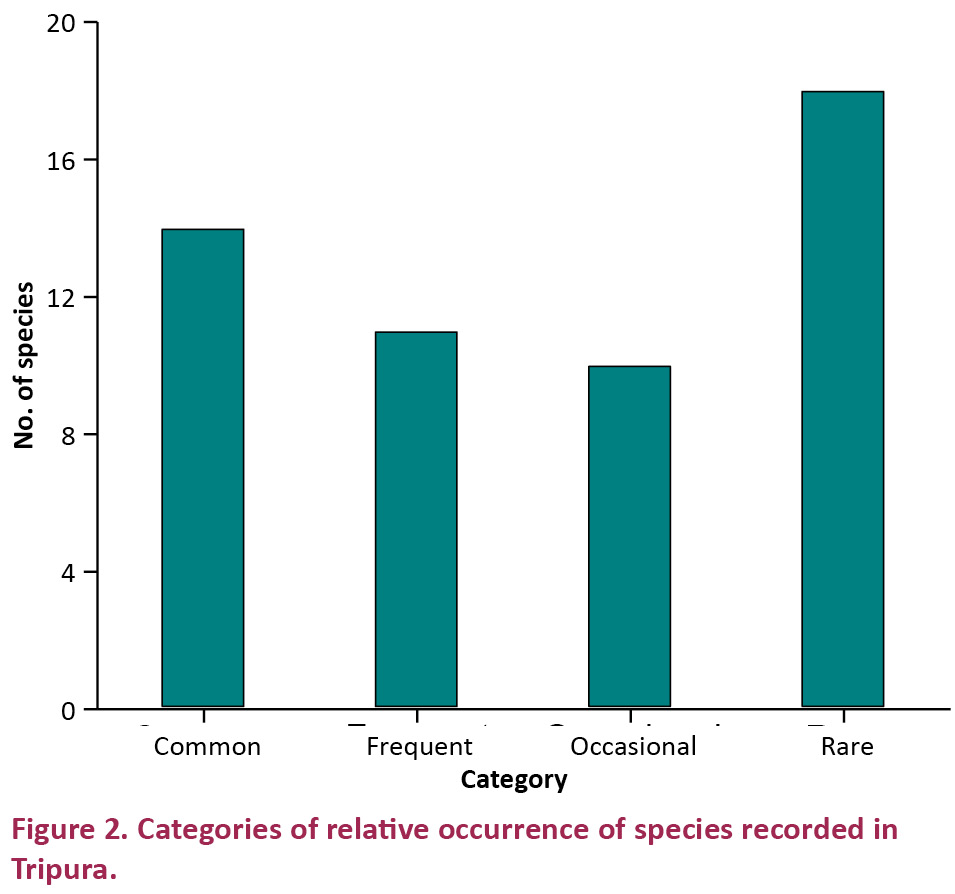
Discussion and Conclusions
Mitra et al. (2010) assessed conservation status and distribution of 367 species of Odanata from six ecoregions of the Eastern Himalaya including two ecoregions viz., the Ganga Delta and Plain freshwater and the Chin Hills-Arakan Coast that extended to Tripura. Previous to this study, quality field data on Odanata was lacking from most of the eastern Himalayan range, particularly from the south and eastern parts including Tripura. The present study is a quantitative as well as qualitative advancement of Odonata diversity of Tripura over the earlier study (Srivastava & Sinha 2000). During the study period, 14 species were recorded as common, 11 frequent, 10 occasional and 18 as rare (Fig. 2). Twenty-five species are new records for the state of Tripura and, therefore, the updated odonate fauna of Tripura State is now represented by 62 species under 39 genera and nine families (Appendix 1). Thirty of these species, representing 48.39% of the Odonata fauna of Tripura, are considered endemic to south-east Asia extending from parts of Nepal on the eastern side to Vietnam on the western side. These include 16 species of dragonflies and 14 species of damselflies (Appendix 1). Ten species or subspecies namely, Ceriagrion olivaceum Laidlaw, Pseudagrion australasiae Selys, Enallagma parvum Selys, Agriocnemis splendidissima Laidlaw, Vestalis smaragdina (Selys), (Fonscolombe), Trithemis kirby kirby Selys, Neurothemis intermedia alanta Ris, Orthetrum brunneum brunneum (Fonscolombe) and Orthetrum chrysis (Selys, 1891) reported in previous works (Srivastava & Sinha 2000; Majumder et al. 2013a) were not recorded during this study and are data deficient. All the 53 species collected in this study are listed in IUCN Red List of threatened category (IUCN 2013).
Destruction of forested areas, pollution of aquatic habitats and filling of increasing numbers of ponds in urban and rural areas are considered to be the important threats to diversity of animals and plants including odonates in Tripura (Bhattacharjee et al. 2013). Several studies have shown that forest cover and water quality have a positive influence on odonate diversity (Dolny et al. 2011). However, it is difficult to say whether a species is genuinely rare or merely overlooked until adequately sampled and assessed. Evaluating the status of naturally rare species is highly important from a conservation stand point. Occurrence of a high degree of endemism in the recorded species of Odonata from this study is a definite indicator of greater species richness and diversity of these insects in South-east Asia in general and in the study area, in particular.
References
Agarwala, B.K. & P.P. Bhattacharjee (2012). Long-horned beetles (Coleoptera: Cerambycidae) and Tortoise beetles (Chrysomelidae: Cassidinae) of Tripura, northeastern India with some new additions. Journal of Threatened Taxa 4(13): 3223–3227; http://dx.doi.org/10.11609/JoTT.02951.3223.7
Balian, E.V., H. Segers, C. Lévêque & K. Martens (2008). The freshwater animal diversity assessment: an overview of the results. Hydrobiologia 595: 627–637; http://dx.doi.org/10.1007/s10750-007-9246-3
Bhattacharjee, P.P., R. Lodh, D. Laskar, J. Majumder & B.K. Agarwala (2013). An ornithological survey in the vicinity of Agartala city of Tripura state, north eastern India. Journal of Research in Biology 3(3): 852–860.
Brown, K.S.J. (1991). Conservation of neotropical environments: insects as indicators, pp. 349–404. In: Collins, N.M. & J.A. Thomas (eds.). The Conservation of Insects and Their Habitats. Academic Press, New York.
Clausnitzer, V. (2003). Dragonfly communities in coastal habitats of Kenya: indication of biotope quality and the need of conservation measures. Biodiversity and Conservation 12: 333–356; http://dx.doi.org/10.1023/A: 1021920402913
Clausnitzer V., V.J. Kalkman, M. Ram, B. Collen, J.E.M. Baillie, M. Bedjanič, W.R.T. Darwall, K.D.B. Dijkstra, R. Dow, J. Hawking, H. Karube, E. Malikova, D. Paulson, K. Schütte, F. Suhling, R. Villanueva, N. von Ellenrieder & K. Wilson (2009). Odonata enter the biodiversity crisis debate: the first global assessment of an insect group. Biological Conservation 142: 1864–1869; http://dx.doi.org/10.1016/j.bicon.2009.03.028
Corbet, P.S. (1999). Dragonflies: Behavior and Ecology of Odonata. Harley Books, Great Horkesly, Colchester, 830pp.
Corbet, P.S. (2006). Forests as habitats for dragonflies (Odonata), pp. 13–36. In: Rivera A.C. (eds.). Forest and Dragonflies. Fourth WDA International Symposium of Odonatology, Pontevedra (Spain), July 2005. Pensoft Publishers, Sofia-Moscow.
Das, S.K., P.K. Sahoo, N. Dash, S. Marathe, S. Mahato, A. Dashahare, P.S. Mishra, A. Prasad & R. Rana (2013). Odonates of three selected tiger reserves of Madhya Pradesh, Central India. Check List 9(3): 528–532.
Das, S.K., R.A. Ahmed, S.K. Sajan, N. Dash, P. Sahoo, P. Mohanta, H.K. Sahu, S.D. Rout & S.K. Dutta (2012). Diversity, distribution and species composition of Odonates in buffer areas of Similipal Tiger Reserve, Eastern Ghat, India. Academic Journal of Entomology 5(1): 54–61; http://dx.doi.org/10.5829/idosi.aje.2012.5.1.62116
Dijkstra, K-DB, J.K. Vincet, R.A. Dow, F.R. Stokvis & J.V. Tol (2014). Redefining the damselfly families: a comprehensive molecular phylogeny of Zygoptera (Odonata). Systematic Entomology 39(1): 68–96; http://dx.doi.org/10.1111/syen.12035
Dolny, A., D. Barta, S. Lhota, Rusdianto & P. Drozd (2011). Dragonflies (Odonata) in the Bornean rain forest as indicators of changes in biodiversity resulting from forest modification and destruction. Tropical Zoology 24: 63–86.
Foote, A.L. & C.L. Rice (2005). Odonata as biological indicators in Canadian prairie wetlands. Ecological Entomology 30: 273–283; http://dx.doi.org/10.1111/j.j.0307- 6946.2005.00701.x
Fraser, F.C. (1933). The Fauna of British - India including Ceylon and Burma, Odonata. Vol. I. London: Taylor and Francis Ltd., 436pp.
Fraser, F.C. (1934). The Fauna of British - India including Ceylon and Burma, Odonata. Vol. II. London: Taylor and Francis Ltd., 442pp.
Fraser, F.C. (1936). The Fauna of British - India including Ceylon and Burma, Odonata. Vol. III. London: Taylor and Francis Ltd., 448pp.
Grimaldi, D. & M.S. Engel (2005). Evolution of the Insects. Cambridge University Press, New York. 755 pp.
Joshi, S. & K. Kunte (2014). Dragonflies and damselflies (Insecta: Odonata) of Nagaland, with an addition to the Indian odonate fauna. Journal of Threatened Taxa 6(11): 6458–6472; http://dx.doi.org/10.11609/JoTT.o3911.6458-72
Kalkman, V.J., V. Clausnitzer, K.D.B. Dijkstra, A.G. Orr, D.R. Paulson & J.V. Tol (2008). Global diversity of dragonflies (Odonata) in freshwater. Hydrobiologia 595: 351–363; http://dx.doi.org/10.1007/s10750-007-9029-x
Majumder, J., R.K. Das, P. Majumder, D. Ghosh & B.K. Agarwala (2013a). Aquatic insect fauna and diversity in urban fresh water lakes of Tripura, north east India. Middle-East Journal of Scientific Research 13(1): 25–32; http://dx.doi.org/10.5829/idosi.mejsr.2013.13.1.66123
Majumder, J., P.P. Bhattacharjee & B.K. Agarwala (2013b). Diversity, distribution and habitat preference of predacious coccinellids (Coleoptera: Coccinellidae) in agro- and forest habitats of Tripura, northeast India. International Journal of Current Research 5(5): 1060–1064.
Majumder, J., R. Lodh & B.K. Agarwala (2012). Variation in butterfly diversity and unique species richness along different habitats in Trishna Wildlife Sanctuary, Tripura, north east India. Check List 8(3): 432–436.
Merritt, R.W., K.W. Cummins & M.B. Berg (2008). An Introduction to the Aquatic Insects of North America. Kendall and Hunt, Dubuque IA, iv+1158pp.
Mitra, A., R. Dow, K.A. Subramanian & G. Sharma (2010). Chapter 5. The status and distribution of dragonflies and damselflies (Odonata) of the Eastern Himalaya, pp. 54–66. In: Allen, D.J., S. Molur & B.A. Daniel (eds.). The Status and Distribution of Freshwater Biodiversity in the Eastern Himalaya, IUCN, Cambridge, UK and Gland, Switzerland.
Mitra, T.R. (2003). Insecta: Odonata, pp. 125–164. In: Director (ed.). Fauna of Sikkim, State Fauna Series 9. Zoological Survey of India Publication, Kolkata, India.
Mitra, T.R. (2006). Handbook of Common Indian Dragonflies (Insecta: Odonata). Zoological Survey of India, 124pp.
Mitra, T.R., M. Prasad & C. Sinha (2006). Insecta: Odonata, pp. 75–87. In: Director (ed.). Fauna of Nagaland, State Fauna Seris 12. Zoological Survey of India Publication, Kolkata, India.
Myers, N., R.A. Mittelmeier, C.G. Mittelmeier, G.A.B. da Fonseca & J. Kent (2000). Biodiversity hotspots for conservation priorities. Nature 493: 853–858.
Nair, M.V. (2011). Dragonflies and Damselflies of Orissa and Eastern India. Wildlife Organisation, Forest and Environment Department, Government of Orissa, 254pp.
Oliver, I. & A. Beattie (1993). A possible method for the rapid assessment of biodiversity. Conservation Biology 7: 562–568.
Osborn, R. (2005). Odonata as indicators of habitat quality at lakes in Louisiana, United States. Odonatologica 34: 259–270.
Prasad, M. (2007). Insecta: Odonata, pp. 143–186. In: Director (ed.). Fauna of Mizoram, State Fauna Seris 14. Zoological Survey of India Publication.
Prasad, M. & R.K. Varshney (1995). A check list of the Odonata of India including data on larval studies. Oriental Insects 29: 385–428.
Samways, M.J., M.A. McGeoch & T.R. New (2010). Insect Conservation: A Handbook of Approaches and Methods. Oxford University Press, Oxford, 441pp.
Schorr, M., M. Lindeboom & D. Paulson (2009). World Odonata List. <http://www.pugetsound.edu/x6140.xml>. On-line version dated 4 June 2013.
Shantibala, T., R.K. Lokeshwari & H.D. Sharma (2012). Entomophagy practices among the ethnic communities of Manipur, north-east India. International Journal of Integrative Sciences, Innovation and Technology 1(5): 13–20.
Silva, D.P., P. De Marco & D.C. Resende (2010). Adult odonate abundance and community assemblage measures as indicators of stream ecological integrity: a case study. Ecological Indicators 10: 744–752; http://dx.doi.org/10.1016/j.ecolind.2009.12.004
Smith, J., M.J. Samways & S. Taylor (2007). Assessing riparian quality using two complementary sets of bioindicators. Biodiversity Conservation 16: 2695–2713; http://dx.doi.org/10.1007/s10531-006-9081-2
Srivastava, V.D. & C. Sinha (2000). Insecta: Odonata, pp. 155–196. In: Director (ed.). Fauna of Tripura, State Fauna Series 7 (Part 2). Zoological Survey of India Publication, Kolkata, India.
Srivastava, V.D. & C. Sinha (2004). Insecta: Odonata, pp. 75–110. In: Director (ed.). Fauna of Manipur, State Fauna Series 10. Zoological Survey of India Publication, Kolkata, India.
Subramanian, K.A. (2009). Dragonflies of India - A Field Guide. Vigyan Prasar, India Offset Press, New Delhi, 168pp.
Sutherland, W.J. (1996). Ecological Census Techniques. Cambridge University Press, Cambridge , USA, 450pp.
The IUCN Red List of Threatened Species (2013). IUCN Red List of threatened species. < http://www.iucnredlist.org/>. On-line version dated 20 June 2013.
Vick, G.S. (2002). Preliminary biodiversity assessment of odonate fauna of the Takamanda Forest Reserve, Camerooon. IDF-Report 4: 1–10.
Westfall, M.J. Jr. & K.J. Tennessen (1996). Odonata, pp. 164–211. In: Merrit, R.W. & K.W. Cummins (eds.). An Introduction to the aquatic insects of North America, 3rd Edition. Kendell/Hunt Publishing Company, Dubuque, Iowa.
Wilson, E.O. (1997). Introduction, pp. 1–3, In: Kudla, M.L., D.I. Wilson & E.O.Wilson (eds.). Biodiversity II. Reaka J. Henry Press, Washington, D.C.
